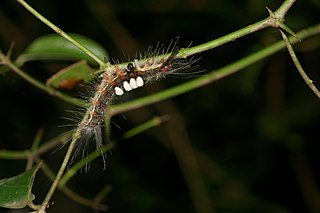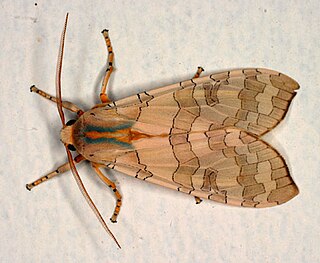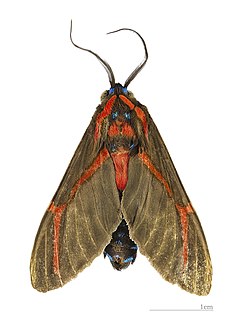
The Arctiinae are a large and diverse subfamily of moths, with around 11,000 species found all over the world, including 6,000 neotropical species. This group includes the groups commonly known as tiger moths, which usually have bright colours, footmen, which are usually much drabber, lichen moths, and wasp moths. Many species have "hairy" caterpillars that are popularly known as woolly bears or woolly worms. The scientific name of this subfamily refers to this hairiness. Some species within the Arctiinae have the word tussock in their common name due to people misidentifying them as members of the Lymantriinae based on the characteristics of the larvae.

The Lymantriinae are a subfamily of moths of the family Erebidae. The taxon was erected by George Hampson in 1893.

The Arctiini are a tribe of tiger moths in the family Erebidae.

The Phaegopterina are a subtribe of tiger moths in the tribe Arctiini, which is part of the family Erebidae. The subtribe was described by William Forsell Kirby in 1892.
Amphelarctia is a monotypic moth genus in the family Erebidae described by Allan Watson in 1975. Its single species, Amphelarctia priscilla, was first described by William Schaus in 1911. It is found in French Guiana, Venezuela, Ecuador, Peru and Costa Rica.
Aphyarctia is a monotypic moth genus in the family Erebidae described by Watson in 1975. Its single species, Aphyarctia surinamensis, described by Rothschild in 1911, is found in French Guiana, Suriname, Ecuador and Bolivia.

Halysidota is a genus of moths in the family Erebidae. The genus was erected by Jacob Hübner in 1819.

Himerarctia is a genus of moths in the family Erebidae. The genus was described by Watson in 1975.
Paracles is a genus of moths in the subfamily Arctiinae. The genus was described by Francis Walker in 1855. The species range from Panama to Patagonia, with quite a few in the southern temperate region of South America.
Regobarrosia is a genus of moths in the family Erebidae described by Watson in 1975.

Viviennea is a genus of moths in the family Erebidae. The genus was described by Watson in 1975.
Emurena fernandezi is a moth of the family Erebidae first described by Allan Watson in 1975. It is found in Guyana.

Himerarctia docis is a moth of the family Erebidae. It was described by Jacob Hübner in 1831. It is found in French Guiana, Guyana, Brazil, Colombia, Peru and Bolivia.
Himerarctia griseipennis is a moth of the family Erebidae. It was described by Walter Rothschild in 1909. It is found in Brazil.
Himerarctia laeta is a moth of the family Erebidae. It was described by Watson in 1975. It is found in Brazil.
Selenarctia flavidorsata is a moth in the family Erebidae. It was described by Watson in 1975. It is found in Brazil.
Sthenognatha toddi is a moth in the family Erebidae. It was described by Maureen A. Lane and Allan Watson in 1975. It is found on Jamaica.
Melanarctia is a genus of moths in the family Erebidae. The genus was described by Watson in 1975.
Cryptolechia viridisignata is a moth in the family Depressariidae. It was described by Strand in 1913. It is found in Equatorial Guinea.






